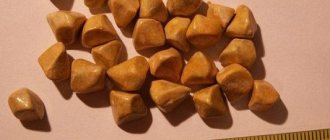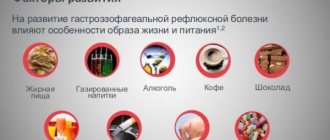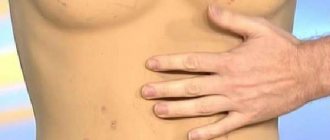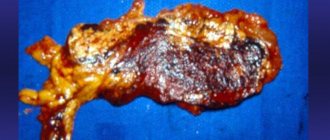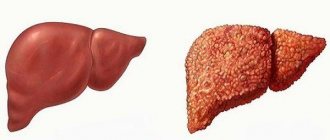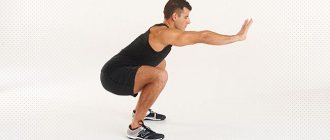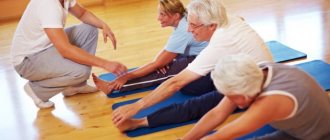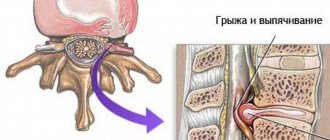The gallbladder is an important organ of the human digestive system. Its function is to accumulate bile coming from the liver and deliver it to the duodenum to participate in the process of digesting food. Anatomically, the gallbladder is part of the liver and is located on its lower surface. Since the organ is involved in the digestion process, disruption of its functioning negatively affects both the condition of neighboring organs and the entire organism as a whole.
Rice. 1. Abdominal organs*
The most common gallbladder diseases are:
- cholecystitis;
- cholelithiasis;
- biliary dyskinesia.
Nobody has canceled the drug treatment of these diseases, however, physical therapy can serve as an excellent means of prevention and can significantly speed up the rehabilitation process for these diseases.
Therapeutic gymnastics and exercises contribute to:
- increased blood flow to the abdominal organs;
- improving the neuropsychic state of a person;
- reduction of spastic and congestive phenomena in the biliary tract;
- stimulation of the outflow of bile into the small intestine;
- development of diaphragm mobility [2].
Rice. 2. Means of exercise therapy and principles of physical therapy for diseases of the gallbladder
Therapeutic exercises for cholecystitis
In simple terms, cholecystitis is an inflammation of the gallbladder. It is customary to distinguish two main forms of this disease: calculous and non-calculous.
In the first case, stones form in the cavity of the gallbladder (cholelithiasis), which injure the mucous membranes and prevent the outflow of bile. Against this background, infection of the gallbladder by intestinal microflora can occur, followed by inflammation of the walls of the organ.
In the second case, the cause is usually a bacterial infection, which provokes the proliferation of connective tissue and, as a result, disrupts the outflow of bile.
Therapeutic exercise can be used for any form of cholecystitis, but not during an exacerbation. Exercise therapy is prescribed in the absence of high fever, severe pain, nausea, vomiting, and dyspeptic disorders. In the case of uncomplicated calculous cholecystitis, exercises can be performed 3-4 days after the exacerbation is relieved [2]. In case of complicated stone cholecystitis, the prescription of physical therapy is purely individual.
When compiling and performing a set of exercises, you must adhere to the following recommendations:
- training duration is 15-30 minutes.
- During the exercises, you need to pause for 2-3 minutes.
- starting positions lying on the left side and on all fours are preferred, although other positions can be used.
- the pace of the exercises is slow, smooth; the number of repetitions of regular exercises is 4-5 times, breathing exercises are 6-8.
- the load on the abdominal muscles is limited, especially at first; It is advisable to train the abs in a lying position, without straining and sudden fluctuations in intra-abdominal pressure.
- the inclusion of breathing exercises in a complex of therapeutic exercises is mandatory.
- After training, it is advisable to lie on your left side and rest for 20-30 minutes [1, 2, 3].
You can start performing a set of exercises only after agreeing with your doctor or exercise therapy specialist.
1. Diaphragmatic breathing. Inhale through your nose while inflating your stomach. Exhale slowly through the mouth, while simultaneously drawing in the stomach (6 times).
2. Lie on your back, arms along your body, legs together. As you inhale, raise your right arm up and bend your left leg at the knee, without lifting your foot off the floor. As you exhale, we return to the starting position (4 times for each pair of arms and legs).
3. Lie on your back, hands on your waist, legs together. As you exhale, raise your shoulders and head so that you can see your toes. We return to the starting position. Let's inhale. Repeat 4 times.
4. Lie on your back, bend your legs, arms along your body. Inhale, and as you exhale, pull your knees and chin toward your chest. Wrap your arms around your legs. Return to starting position. Do it 4 times.
5. Lie on your back, arms along your body, legs together. Bend your right leg, straighten it, then do the same with the other leg. The exercise should imitate walking. Perform for 1 minute.
6. Lie on your back, legs bent, feet and knees together. Alternately tilt the closed knees in different directions (4 times). The exercise is performed after inhaling and exhaling.
7. Lie on your back, arms along your body, legs together. Bend your right leg, straighten it, return to the starting position. Do the same with the other leg (4 times each).
8. Lie on your back, rest your elbows on the floor, legs bent, feet slightly apart. After inhaling, as you exhale, lift your pelvis. Return to starting position (4 times).
9. Lie on your left side, your left leg is bent, your left hand lies on the floor, continuing the line of the body. As you inhale, raise your right arm to the side until parallel with your left arm. As you exhale, bring your right knee to your chest, pressing it to your body with your right hand. We return to the starting position. Repeat 4 times.
10. Lie on your left side, left hand under your head. As you inhale, raise your right leg and arm up, and as you exhale, pull your bent right leg toward your chest, pressing it with your hand. At the same time, we also press the chin to the chest. Return to i.p. Repeat 4 times.
11. Lie on your left side, left hand under your head. As you exhale, raise your right arm up, then move it back. As you exhale, return to IP. 4 approaches.
12. Lie on your left side, left hand under your head. As you inhale, move both legs back, and as you exhale, bring your bent legs to your chest (4 times).
13. Diaphragmatic breathing. Inhale through your nose while inflating your stomach. Exhale slowly through the mouth, while simultaneously drawing in the stomach (6 times).
14. Get on all fours. Bring your leg toward your chest, then extend it back. Return to starting position (4 times for each leg).
15. Get on all fours. As you inhale, raise your right arm to the side, then bring it forward. As you exhale, return to the starting position. Repeat 4 times for each hand.
16. Get on all fours. Straighten your legs, lifting your pelvis up. Return to starting position. Legs and arms should remain in one place. Do the exercise 4 times.
17. Sit on the floor, lean back, leaning on your slightly bent arms. Raise your legs up. Return to starting position (4 times).
18. Sit on the floor, legs apart as wide as possible, hands on your belt. We try to reach the opposite toe of the foot with our hand (4 times for each hand).
19. Sit on the floor, feet shoulder-width apart, arms to the sides. We make turns with the body (4 times in each direction).
20. Sit on a chair. Place your right hand on your chest, your left hand on your stomach. We inhale slowly without the participation of the chest, the diaphragm goes down, while the stomach protrudes. This movement is recorded by the left hand. We continue to inhale, but this time through the chest. This is fixed by the right hand. The chest rises, the shoulders turn, and the head leans back a little. We begin to exhale slowly without the participation of the chest, the diaphragm goes up, and the stomach retracts. This movement is recorded by the left hand. We continue to exhale, but this time through the chest. This is fixed by the right hand. The chest drops, the shoulders come together, the head drops to the chest. We hold our breath. Repeat the exercise 6 times.
21. Sitting on a chair. Inhale, and as you exhale, pull the bent leg toward your stomach. Return to i.p. Repeat 4 times with each leg.
22. Sit near a chair, resting your hands on the chair. Stand up without lifting your arms and legs from their starting positions. The hips should form a straight line with the body if possible. Your arms can be fully straightened. The knees remain bent. Return to starting position. Do it 4 times.
23. Stand near a chair, holding the back with a bent hand. The other hand is on the belt. Bend in the opposite direction from the chair. Return to i.p. Repeat 4 times and change sides.
24. Stand near a chair, holding the back with your hand. The other hand is on the belt. Raise your leg and move it to the side. Return to i.p. Repeat 4 times and change legs.
25. Standing, hands on your belt, feet shoulder-width apart. We bend left and right (4 times in each direction).
26. Standing, arms along the body, feet shoulder-width apart. As you inhale, lift your arms up to the sides. As you exhale, we return to IP. 4 times.
27. Walking in place with high leg lifts and intense arm movements (1 minute).
28. Diaphragmatic breathing. Inhale through your nose while inflating your stomach. Exhale slowly through the mouth, while simultaneously drawing in the stomach (6 times).
In addition to performing a daily set of exercises, patients are recommended to walk and swim. In addition, to increase the effectiveness of treatment, you can perform several exercises from the complex during the day, outside of the main workout [2].
Complications after cholecystectomy
After cholecystectomy, intense physical labor, professional sports, and stress on the abdominal muscles are limited for a year. The duration of the restriction period may be extended depending on the patient's condition. Some restrictions also apply to therapeutic exercises. Jumping, running or sudden exercises should not be performed. Excessive load on the body can threaten the patient with the formation of a postoperative hernia:
- Overweight patients should constantly wear a bandage that can support the abdominal muscles, weakened after the intervention. The duration of wearing the bandage is determined by the doctor, since the recovery period is different for everyone;
- after laparoscopy, pain and frequent problems with the digestive organs appear. When the functionality of the biliary system is disrupted, dyspepsia, stomach diseases and discomfort in the intestinal tract often appear.
Patients complain of flatulence and diarrhea, and constipation may also occur. The relationship between the biliary organ and other systems is disrupted after removal of the gallbladder, which leads to poor breakdown of food and disruption of microflora in the intestinal tract. The bile secreted by the liver is not enough to neutralize pathogenic bacteria in the duodenum.
The substance has insufficient concentration, disinfection is too slow, microorganisms have time to form a focus of inflammation. The functioning of the gastrointestinal tract is disrupted. To recover, the patient must undergo comprehensive treatment depending on the cause. Therapy involves taking antibiotics and probiotics taken in courses.
Read also: Why is palpation of the gallbladder necessary?
Exercises for the outflow of bile (for biliary dyskinesia)
Biliary dyskinesia is a disease characterized by a disorder of the motor function of the gallbladder and its ducts. As a result, the outflow of bile is disrupted, digestive problems arise, and other diseases of the biliary system begin to develop, for example, cholelithiasis.
Physical therapy for biliary dyskinesia is aimed at:
- restoration of motor function of the gallbladder and its ducts.
- normalization of the tone of the smooth muscles of the biliary system.
- increased blood supply to the abdominal organs [3].
The exercise therapy used will differ for different forms of the disease.
In the hypokinetic form, the outflow of bile is slowed down. Patients, as a rule, are bothered by dull, prolonged pain in the right hypochondrium, often of a bursting nature. Sometimes dyspepsia may occur [1]. The complex of therapeutic exercises for the hypokinetic form of biliary dyskinesia meets the following principles:
- Lesson duration 15-30 minutes.
- a variety of starting positions are used: lying on your back, on your side, on all fours, sitting and standing.
- breathing exercises are included to help reduce pain, abdominal exercises, muscle relaxation exercises, and general developmental exercises for the lower and upper extremities.
- Bending and rotating the body are not recommended, as these movements can cause nausea and belching.
- the pace and amplitude of the exercises gradually increase [1, 2, 4].
The hyperkinetic form is characterized by short-term pain that occurs after physical exertion, excitement, nervous overload, and is often accompanied by nausea, vomiting, bowel dysfunction, as well as irritability and headache [1]. The therapeutic gymnastics complex meets the following requirements:
- Lesson duration 15-20 minutes.
- starting positions: lying on your back and on your side.
- The pace of the exercises is slow and medium.
- the load is small with a gradual increase to medium.
- Breathing exercises, swing exercises, to relax muscles are recommended.
- Abdominal exercises with weights are not recommended [1, 2, 4].
During the period of complete remission for any form of dyskinesia, physical activities such as walking, swimming, skiing, and skating are acceptable. In the hypokinetic form, outdoor games and cycling are also allowed.
The first 15 exercises from the complex for cholecystitis are perfect for maintenance therapy for biliary dyskinesia. The exercises given in the position on the left side can also be performed on the right. Lying on the right side facilitates the free movement of bile to the neck of the gallbladder and along the cystic duct [4].

